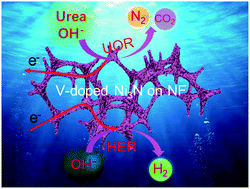3D self-supported porous vanadium-doped nickel nitride nanosheet arrays as efficient bifunctional electrocatalysts for urea electrolysis†
Abstract
Electrocatalytic water splitting is an up-and-coming method to produce H2, but it is mostly limited by the sluggish anodic oxygen evolution reaction (OER). Replacing the OER with the urea oxidation reaction (UOR) process with a low thermodynamic potential would significantly reduce energy consumption. Here we developed porous V-doped Ni3N nanosheets arrays grown on nickel foam (labeled V–Ni3N/NF) by a hydrothermal and subsequent nitridation process. As a bifunctional electrocatalyst, the V–Ni3N/NF shows striking catalytic performances for the hydrogen evolution reaction (HER) and UOR, which require low potentials of −83 mV and 1.361 V to drive a current density of 10 mA cm−2, respectively. Furthermore, when applying V–Ni3N/NF as both the cathode and anode for the HER and UOR, the assembled electrolyzer needs small cell voltages of 1.416 and 1.543 V to achieve 10 and 100 mA cm−2, which are 180 and 243 mV lower than that in traditional water electrolysis, as well as displaying remarkable stability over 200 h. The excellent catalytic performances can be attributed to the self-supported porous nanosheet arrays on 3D NF, the intrinsic conductivity of V–Ni3N, and the optimized Gibbs free energy of hydrogen adsorption after V doping. Our result suggests that this attractive material has promising applications in energy-saving H2 production and urea-related waste water treatment.



 Please wait while we load your content...
Please wait while we load your content...